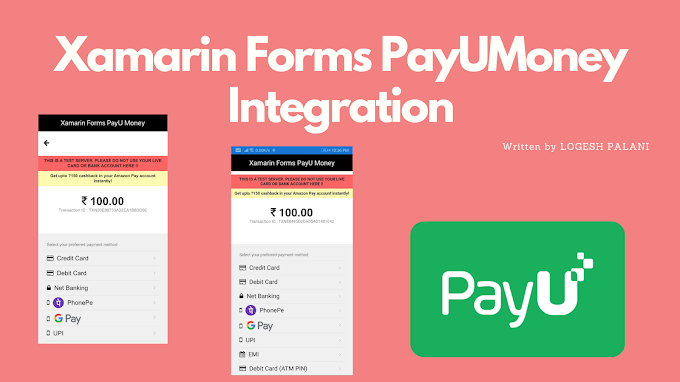Introduction Displaying charts in mobile apps has always been a great way to offer users a clear overview of numerical data. I want this task to be as easy as writing a few lines of code, but I couldn't find a straight-forward way to achieve this. This is why I started exploring SkiaSharp and created Microcharts.
NuGet Package : Xamarin.Forms = search "Microcharts.Forms"
This simple plugin can display microcharts in Xamarin.Forms.
Available charts Microcharts.Forms Plugin
- Barchart
- PointChart
- LineChart
- DonutChart
- RadialGaugeChart
- RadarChart
Chart Types
1. BarChart
- Chartview.Chart = new BarChart(){Entries = entries};
2. PointChart
- Chartview.Chart = new PointChart(){Entries = entries};
3. LineChart
- Chartview.Chart = new LineChart(){Entries = entries};
4. DonutChart
- Chartview.Chart = new DonutChart(){Entries = entries};
5. RadialGaugeChart
- Chartview.Chart = new RadialGaugeChart(){Entries = entries};
6. RadarChart
- Chartview.Chart = new RadartChart(){Entries = entries};
Step 1 You can create Xamarin.Forms app by going to File >> New >> Visual C# >> Cross Platform >> Cross Platform App (Xamarin.Native or Xamarin.Forms), give the application name and press OK.
(Project name: MicrochartsApp)
(Project name: MicrochartsApp)
Step 2 Now, add the following NuGet Package for your projects.
- Microcharts.Forms
For that, go to Solution Explorer and select your solution. Right-click and select "Manage NuGet Packages for the Solution". Now, select the following NuGet Package, select your project, and install it.
- Microcharts.Forms
Step 3
To display a chart, we'll need to host it in a ChartView.
To display a chart, we'll need to host it in a ChartView.
After installing NuGet packages, add a ChartView control to your project. For that, go to Solution Explorer >> MicrochartsApp(PCL) >>> Double-click on MainPage.xaml. After opening this, you can add assembly and XAML code to your project. Here is the code for this page.
Assembly
- xmlns:forms="clr-namespace:Microcharts.Forms;assembly=Microcharts.Forms"
XAML code
- <?xml version="1.0" encoding="utf-8" ?>
- <ContentPage xmlns="http://xamarin.com/schemas/2014/forms"
- xmlns:x="http://schemas.microsoft.com/winfx/2009/xaml"
- xmlns:local="clr-namespace:MicrochartsApp"
- x:Class="MicrochartsApp.MainPage"
- xmlns:forms="clr-namespace:Microcharts.Forms;assembly=Microcharts.Forms">
- <ScrollView>
- <StackLayout Orientation="Vertical">
- <forms:ChartView x:Name="Chart1"
- HeightRequest="150"/>
- <forms:ChartView x:Name="Chart2" HeightRequest="150" />
- <forms:ChartView x:Name="Chart3"
- HeightRequest="150"/>
- <forms:ChartView x:Name="Chart4"
- HeightRequest="150"/>
- <forms:ChartView x:Name="Chart5"
- HeightRequest="150"/>
- <forms:ChartView x:Name="Chart6" HeightRequest="160"/>
- </StackLayout>
- </ScrollView>
- </ContentPage>
Step 4 In this step, add data entries. For that, open Solution Explorer >> MicrochartsApp(PCL) >>click open MainPage.xaml.cs. This class code is given below.
Every chart displays via Microcharts and consumes a set of data entries. They will always have the same structure regardless of the chart type that you want to display.
Every chart displays via Microcharts and consumes a set of data entries. They will always have the same structure regardless of the chart type that you want to display.
Each entry
- Floating number representing it's value is required.
- Label - what your entry is associated with.
- ValueLabel - format your value
- Color - entry
- using Microcharts;
- using SkiaSharp;
- using Microcharts.Forms;
- using System;
- using System.Collections.Generic;
- using System.Linq;
- using System.Text;
- using System.Threading.Tasks;
- using Xamarin.Forms;
- using Entry = Microcharts.Entry;
- namespace MicrochartsApp
- {
- public partial class MainPage : ContentPage
- {
- List<Entry> entries = new List<Entry>
- {
- new Entry(200)
- {
- Color=SKColor.Parse("#FF1943"),
- Label ="January",
- ValueLabel = "200"
- },
- new Entry(400)
- {
- Color = SKColor.Parse("00BFFF"),
- Label = "March",
- ValueLabel = "400"
- },
- new Entry(-100)
- {
- Color = SKColor.Parse("#00CED1"),
- Label = "Octobar",
- ValueLabel = "-100"
- },
- };
- public MainPage()
- {
- InitializeComponent();
- Chart1.Chart = new RadialGaugeChart() { Entries = entries };
- Chart2.Chart = new LineChart() { Entries = entries };
- Chart3.Chart = new DonutChart() { Entries = entries };
- Chart4.Chart = new BarChart() { Entries = entries };
- Chart5.Chart = new PointChart() { Entries = entries };
- //Chart6.Chart = new RadarChart() { Entries = entries };
- }
- }
- }
Step 5
Now, go to "Build" menu and configure your startup project. After configuring, run your project. You will have the result like below.
Now, go to "Build" menu and configure your startup project. After configuring, run your project. You will have the result like below.
Finally, we have successfully created Xamarin.Forms Microcharts application.












0 Comments
You're comment here